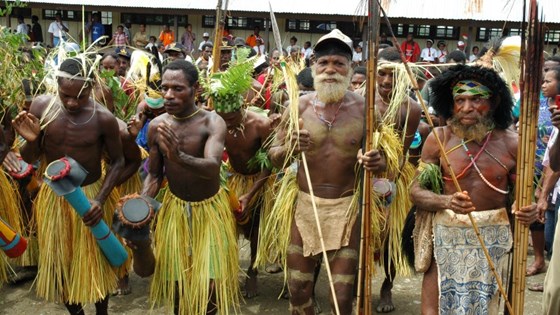Indigenous peoples and forests
Historical archive
Published under: Solberg's Government
Publisher: Ministry of Climate and Environment
Article | Last updated: 08/11/2016
The engagement of Indigenous Peoples and communities will be a crucial determinant of success for the new global framework on climate change.

Indigenous peoples protect forests and climate
Indigenous peoples (IPs) and local communities are highly vulnerable to the effects of climate change. When their rights are recognized by national governments, they are also among the most effective defenders and managers of the world’s forests, the only safe, natural and proven technology we have for carbon capture and storage.
While they make up a small proportion of the world's population, indigenous peoples manage tropical forest areas the size of China. According to a report produced by the Rights and Resources Initiative and the World Resources Institute, almost 38 billion tonnes of carbon is stored in forests where Indigenous Peoples have rights of use. Strong evidence, including from NICFI partners countries, suggest that where Indigenous Peoples have been empowered and their rights respected, forests generally remain standing. This report, prepared for the UNFCCC COP21 in Paris in December 2015, argues that indigenous territories located in the Amazon Basin, the Mesoamerican region, the Democratic Republic of Congo (DRC) and Indonesia contain at least a fifth of the aboveground carbon stored in tropical forests.
When community rights to forests are legally recognized and protected by governments, deforestation rates and greenhouse gas emissions are lower. Moreover, a recent report from the World Resources Institute (WRI) quantifies for the first time the economic value of securing land rights for the communities who live in and protect forests.
In the context of REDD+, we say that we have to make standing forests worth more living than dead. A core strategy for NICFI to achieve that is to cooperate closely with partner countries to honour and enable the efforts of Indigenous Peoples to maintain those forests. Despite indigenous peoples clear contributions to climate change mitigation and adaptation, it is however often the case that their voices go unheard in decision-making processes.
How NICFI works with indigenous peoples
In country partnerships
Indigenous peoples' rights have been a high priority in NICFI's international work to protect the world's tropical forests. This is reflected in our climate and forest partnerships with countries such as Brazil, Colombia, Guyana, Peru and Indonesia.
In September 2016, the United Nations Independent Expert on human rights and international solidarity (appointed by the UN Human Rights Council), visited Norway. In the Preliminary Findings from the visit, it is stated that "within the framework of its programs on the Climate and Forest Initiative, Norway has established a series of partnerships with key forest countries and contributed to significant advances in the development of a REDD+ mechanism under the UN Framework Convention on Climate Change. It is noted with appreciation that within this framework Norway has engaged in building the capacity of indigenous peoples and local forest communities by encouraging its project partners to consult with and involve them in their processes."
Through support for civil society organizations
Indigenous peoples as a priority is also reflected in direct support, through Norad's climate and forest funding window, to Indigenous Peoples Organizations and other civil society organizations supporting indigenous peoples, participatory forest management, forest tenure and land rights. They include support for indigenous peoples and traditional communities to defend forests in collaboration with national governments in Indonesia, Colombia, Guyana, Vietnam, Myanmar, and in several more countries through measures to address illegal logging and forest crime, mapping and documentation of indigenous territories, and through access to remote sensing.
In the climate negotiations
At COP22 in Marrakesh, Norway has the pleasure to work with the Indigenous Peoples Climate Caucus and the UNDP on a special pavilion dedicated to the climate actions of Indigenous Peoples and other forest dependent communities. This is the third year that Norway supports the participation of Indigenous Peoples at the UNFCCC negotiations. Similar events in Lima and Paris contributed significantly to highlighting the role and contribution of Indigenous Peoples and traditional communities in our efforts to limit global warming.
In 2015 the Government of Norway, in partnership with UNDP and the International Indigenous Peoples’ Forum on Climate Change, launched an ambitious initiative to ensure indigenous voices would be heard at the Paris Climate Conference, known as COP21. The initiative created platforms, consultations and political space for IPs to have unprecedented dialogue with national governments on climate and forest policy and ensured that their priorities, needs and aspirations directly informed the Paris Agreement on Climate Change.
The participation of Indigenous Peoples in national and international processes contributed to a stronger, more effective, and more equitable climate outcome. This was made possible by the efforts of the Indigenous Peoples’ Caucus to consult their constituencies and advance dialogue with governments. The joint initiative contributed to:
- The rights and priorities of indigenous peoples and traditional communities were formally embedded in important articles the Paris Agreement on Climate Change.
- There was a sea-change in public understanding of the role of Indigenous Peoples and traditional communities in mitigating climate change.
- The unprecedented engagement between Indigenous Peoples, traditional communities and national governments contributed to national and global climate policy, at a scale greater than ever before.
- Lasting platforms for engagement, advocacy and knowledge sharing were created that will continue to highlight the visibility and impact of indigenous peoples and traditional communities in the fight to limit global warming.